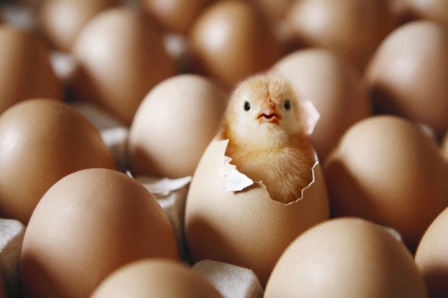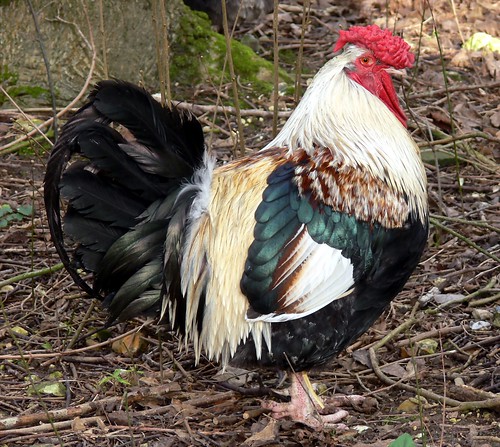Food chickens can eat!!!
Apples...........Raw and applesauce................Apple seeds contain cyanide, but not in sufficient to quantities to kill
Asparagus ............ Raw or cooked.................. okay to feed, but not a favorite.
Bananas ....................without the peel .................High in potassium, a good treat.
Beans............... well-cooked only, NEVER DRY................Also, green beans.
Beets...............Greens also.......................
Berries...............All kinds..............a treat, especially strawberries.
Breads...............All kinds-good use for stale bread or rolls...........Feed starches in moderation.
Broccoli & Cauliflower..........Tuck into a suet cage and they will pick at it all day.
Cabbage & Brussels Sprouts.........Whole head-............Hang a whole cabbage from their coop ceiling in winter so they have something to play with and greens to eat.
Carrots ..... Raw and cooked......They like carrot foliage too.
Cat food..... Wet and dry......Feed in moderation, perhaps only during moulting
Cereal.......Cheerios, ect..........Avoid highly sugared cereal such as Coco puffs, ect.
Cheese......Including cottage cheese......... Feeding in moderation, fatty but a good source of protein and calcium
Cooked Chicken ........... They may like it and it won't kill them, but it just seems so.... ummm... .. wrong.
Corn..... Om cob and canned, raw and cooked.
Crickets ( alive )........ Can be bought at bait or pet-supply stores.......Great treat - provides protein and it's fun to watch the chickens catch them.
Cucumbers...... Let mature for yummy seeds and fresh.
Eggs...... Hard cooked and scrambled are a good source of protein, and a favorite treat....... Feed cooked eggs only because you don't want your chickens to start eating their own raw eggs.
Eggplant ..............
Fish / Seafood.......... Cooked only.
Flowers..... Make sure they haven't been treated with pesticides, such as florist flowers might be.............Marigolds, nasturtiums, pansies, ect.
Fruit...... Pears, peaches, cherries, apples.
Grains..... Bulgar, flax, niger, wheat berries, ect.
Grapes..... Seedless only. For chicks, cutting them in half makes it easier for them to swallow. ....... Great fun- the cause of many entertaining " chicken keep away" games.
Grits.......Cooked
"Leftovers".......... Only feed your chickens that which is still considered edible by humans, don't feed anything spoiled, moldy, oily, salty or unidentifiable.
Lettuce / Kale............Any leafy greens, spinach collards, chickweed included......... A big treat, depending on how much other greenery they have access to.
Meal worms..... Available at pet supply stores or on the Internet , although shipping is expensive!............. A huge(!) favorite treat, probably the most foolproof treat on the books.
Meat scraps of any kind......... Not to fatty............In moderation, a good source of protein.
Melon.... Cantaloupe, etc........Both seeds and flesh are good chicken treats.
Oatmeal.....Raw or cooked....... Cooked is nutritionally better.
Pasta / Macaroni.......Cooked spaghetti, ect....... Cooked is nutritionally better.
Peas........ Peas and pea tendrils and flowers
Peppers (bell)......
Pomegranates.......Raw..........Seeds are a big treat.
Popcorn............ popped, no butter, no salt.
Potatoes/ sweet Potatoes / Yams......... Cooked only- avoid green parts of peels!......... Starchy, not much nutrition.
Pumpkins / Winter Squash...........Raw or cooked.........Both seeds and fresh are a nutritious treat.
Raisins......
Rice.... Cooked only........ Pilaf mixes are okay too, plain white rice has little nutrition.
Scratch............Scratch is cracked corn with grains ( such as wheat, oats and rye ) mixed in. ...........Scratch is a treat for cold weather, not a complete feed. Toss it on the ground and let them scratch for it for something to do.
Sprouts..... Wheat and oats sprouts are great!..... Good for greens in mid-winter.
Summer Squash......Yellow squash and zucchini.......Yellow squash not a huge favorite, but okay to feed.
Sunflower seed....Sunflower seeds with the shell still on is fine to feed, as well as with the shell off......... a good treat, helps hens lay eggs and grow healthy feathers.
Tomatoes........Raw and cooked........
Turnips.... Cooked...... Not huge favorite....
Watermelon....... Served cold, it can keep chickens cool and hydrated during hot summers.........Seeds and flesh are both okay to feed.
Yogurt..... Plain or flavored...... A big favorite and good for their digestive systems. Plain is better.
ALL Chickens like different stuff. Then other chickens do.
Food chickens can't eat!
Raw green potato peels....... Toxic substance called solanine.
Anything real salty........Can cause salt poisoning in small bodies such as chickens.
Citrus.............
Dried or undercooked Beans...... Raw, or dry beans, contains a poison called hemoglobin which is toxic to birds.
Avocado Skin and Pit.......Skin and pit have low levels of toxicity.
Raw eggs....... You don't want to introduce your chickens to the tastiness of eggs which many be waiting to be collected in the nest boxes.
Candy, Chocolate, Sugar........Their teeth will rot_ _ NO, It's just bad for their systems, chocolate can be poisonous to most pets.
http://www.backyardchickens.com/a/chicken-treat-chart-the-best-treats-for-backyard-chickens





